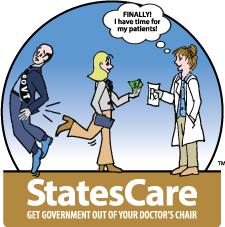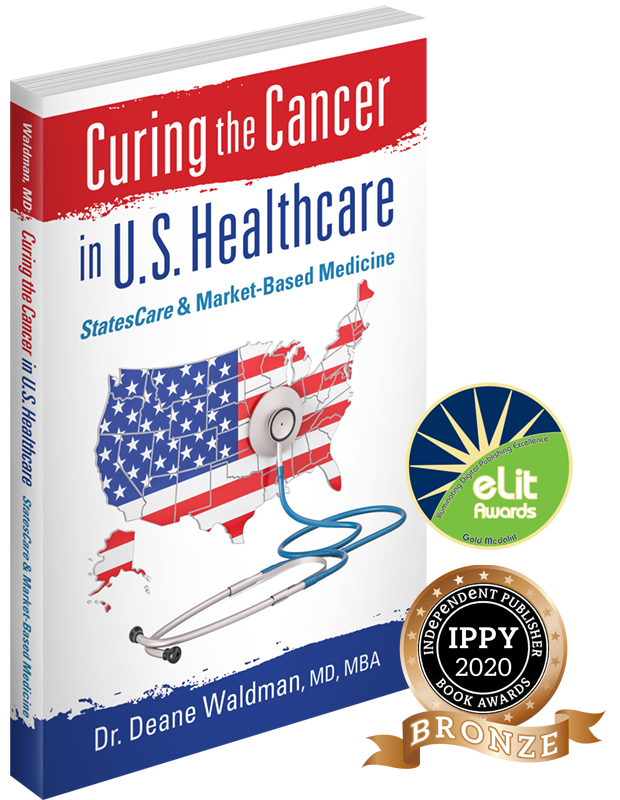
CoViD-19 Cost/Benefit Analysis Concludes: Let My People Go
By Deane Waldman, MD MBA - 07/04/20
When the CoViD-19 (Corona Virus Disease, 2019) first broke out, there was little-to-no data. Without factual evidence, medical advisers had to depend on mathematical models such as the MRC Centre for Global Infectious Disease Analysis from the Imperial College in London. With an estimate of more than 2 million American deaths, a draconian response was instituted with a nearly-complete cessation of social and commercial interactions. Most people are now functioning under a lock-down, travel ban, and infringement on civil liberties analogous to martial law.
With five months data since the virus was identified in Wuhan, and with the entire globe focused on one subject only, there are now reams of data on CoViD-19, from its genome to its behavior and clinical consequences as well as daily reports of infected cases and deaths. With volumes of evidence now available, it is time to reconsider what we are doing. A cost/benefit analysis can help advise whether we should stay the course or change.
Costs
The most important cost is not quantifiable--lives lost because of our response to CoViD-19, not because of viral illness. The healthcare system is overwhelmed with CoViD-19 patients. People with other ailments have great difficulty getting care or even medical attention. How many will die because of delay in either diagnosis or treatment of a non-CoViD-19 condition? The number of needless deaths could easily exceed CoViD-19 related deaths.
In 2018, 48,344 Americans committed suicide at a time when the economy was booming and personal incomes were rising. At present, with great economic hardship due to government enforced unemployment and social isolation, people are depressed, and many more may take their own lives. That number alone could exceed the number of CoViD-19 deaths.
The attempt to "flatten the curve" of CoViD-19 spread has produced a crushing economic cost.. Most of the middle class has been placed on government-mandated extended furlough without pay, from construction and manufacturing to all service industries except healthcare and food. The loss in income will devastate millions of families and the $2.2 trillion bailout will barely scratch the surface of devastation. There has never been a time in our history when as many people went from employed to suddenly unemployed, even during the great Depression. Even as we spend an additional $2.2 trillion, tax revenues will plummet from workers no longer being paid.
Another economic damage, incalculable now but eventually quantifiable, is the number of businesses that will close. Without economic activity that generates revenue, how long can a dry cleaner, a hair salon, or an auto dealership stay in business? When they close their doors, employees will be permanently rather than temporarily out of work.
There is also the cost of increased crime during lock-downs, including burglaries and care theft. Finally, there is the price paid in loss of civil liberties: freedom to move about, to gather in groups, even to attend church. This is another unquantifiable but all-too-real cost of how we responded to CoViD-19.
Benefits
As of this writing (April 6, 2020) there are 337,971 confirmed U.S. cases and 9,654 deaths attributed to CoViD-19. The rationale behind our current response is first to save lives. Some of these deaths are because of the viral infection in that person. Other deaths, possibly the majority, attributed to the virus are in fact people who die because of their pre-existing life-threatening medical condition, who happen to test positive for CoViD-19. Note that 19 of the first deaths were all in a nursing home. Medical demographic data show that a majority of "CoViD-19 deaths" were in patients who had chronic lung disease, heart disease, kidney failure, immune deficiency likely due to age, diabetes, or other serious chronic medical conditions.
In the current media-generated panic, some have compared CoViD-19 to Ebola or even the bubonic plague of the middle ages. Based on the number above, CoViD-19 has a case fatality rate (CFR) of 2.85 percent--Ebola kills 88 percent of infected, healthy persons. The risk to the general population is considerably lower than 2.85 per cent as the virus tends to attack debilitated and immune-impaired persons rather than the healthy population.
Comparison of CoViD-19 with other causes of death in the U.S. can help produce a more accurate perspective instead of the panic that is currently prevalent.
In the flu outbreaks of 2017-18 and 2018-19, 48.8 million and 42.9 million Americans respectively were infected. There were 959,000 and 647,000 hospitalizations in the two successive years. Of the infected, 79,400 (2017-2018) and 61,200 (2018-2019) died. The flu killed seven to eight times the number of deaths currently attributed to CoViD-19.
The leading cause of death in the U.S. in 2017 was heart disease: 647, 457 or 1774 persons per day. In 2018, traffic fatalities and gun violence combined caused 78, 177 deaths, while last year, opioid deaths were 47,450. CoViD-19 deaths are a small fraction of leading causes of death.
In terms of sickness, U.S. 41,559 CoViD-19 patients have been hospitalized. During past flu outbreaks, 959,000 and 647,000 Americans were hospitalized in 2017-18 and 2018-19. Nearly 5,500 Americans have needed ICU beds. The American Hospital Association reports there are 96,596 ICU beds in the country, with more than 3000 ICU beds in New York city.
Stopping a pandemic
The rationale behind social distancing and the state lock-downs is to slow the spread of the virus with the hope that "flattening the curve" would save lives. This approach will not defeat the virus or stop the pandemic. It may slow it.
The way to stop or prevent an epidemic is well known: herd immunity. Small pox infection (Variola Major virus) killed hundreds of millions a year until mass vaccination was implemented starting in 1958. On Dec 9, 1979, scientists announced the official eradication of the scourge of small pox by creation of world-wide herd immunity.
When a highly contagious virus attacks a susceptible, i.e., non-immune, population or "herd," a pandemic develops by chain reaction. One person infects two people, those two infect two more, four becomes 16, then 64, and soon you have thousands, even millions infected. During the 2018-2019 flu season, nearly 43 million Americans were infected. Though there was a flu vaccine available, it was for the 2017 strain, not the 2018 virus and therefore, the population was susceptible, non-immune.
When a highly contagious virus attacks an immune herd, the single infected person can only find one other susceptible who in turn cannot pass on the infection because most of the herd is immune. Herd immunity prevents the chain reaction. The pandemic either stops or never gets started.
To stop the CoViD-19 pandemic, we need herd immunity. Since no vaccine is currently available, we must develop immunity naturally. With the low risk to the general population, it is safe to allow the infection to spread and for the population to build their own antibodies.
Conclusion and Recommendations
When the CoViD-19 virus first came to the U.S., there was little data available other than it seemed to be highly contagious and might be deadly. Social distancing, travel bans, and lock-downs were intended to contain, not stop, the epidemic. The hoped-for benefit was saving lives and reducing the burden on an overwhelmed healthcare system.
Despite the daily reports of CoViD-19 statistics like baseball scores during the world series, we now know the risk to the general, healthy population is very low, probably less than the last two flu epidemics. Containment strategy could kill more Americans by inability to get timely care and suicide than die by virus. And the financial cost is staggering. The price to Liberty is incalculable.
The putative gains from the current U.S. lock-down strategy does not justify the attendant costs. Continuing self-incarceration may cost more lives than it saves.
The U.S. should change its approach to CoViD-19 as follows.
First, to protect the small high-risk population, i.e., those with serious pre-existing medical conditions and the elderly, offer strict quarantine and with all necessary medical care provided within isolation.
Second, let my people go (Exodus 5:1). Reverse the lock-down, stop the social distancing. This will allow the low-risk, healthy population to develop herd immunity with little fear of death. This will also speed up the recovery of our economy before the damage is irreparable.
Third, expand testing to the asymptomatic population so we can develop a clearer picture of CoViD-19 epidemiology. At present, we have no accurate data on how many Americans are or were infected and are asymptomatic, the key denominator of all percentages.
Fourth, continue testing curative drugs, such as hydroxychloroquine+/-Azithromycin, remdesivir, vitamin C, zinc, etc. Continue work on development of a vaccine.
This four-pronged approach is the best way to restore both medical and fiscal health to the people of the United States.
Why Read This Article:
This four-pronged approach is the best way to restore both medical and fiscal health to the people of the United States. sss
By Deane Waldman, MD, MBA, author of "Curing the Cancer in U.S. Healthcare"
Professor Emeritus of Pediatrics, Pathology and Decision Science, and holds the "Consumer Advocate" position on the Board of Directors of the New Mexico Health Insurance Exchange, and Adjunct Scholar (Healthcare) for the Rio Grande Foundation.
Mailing address:
ADM Consulting & Books
PO Box 37396
Albuquerque, New Mexico 87176-7396
Copyright © 2015-2019 ADM Consulting & Books. All Rights Reserved. All other trademarks on this site are the property of their respective owners. Site design and maintenance by www.DesignStrategies.com.



